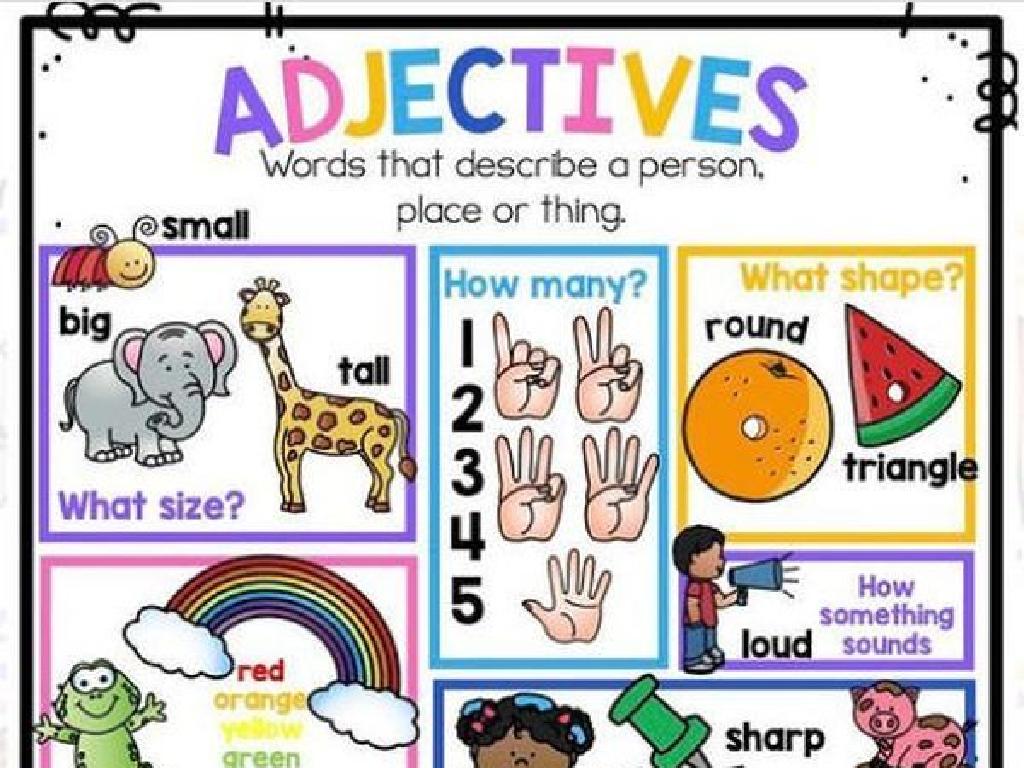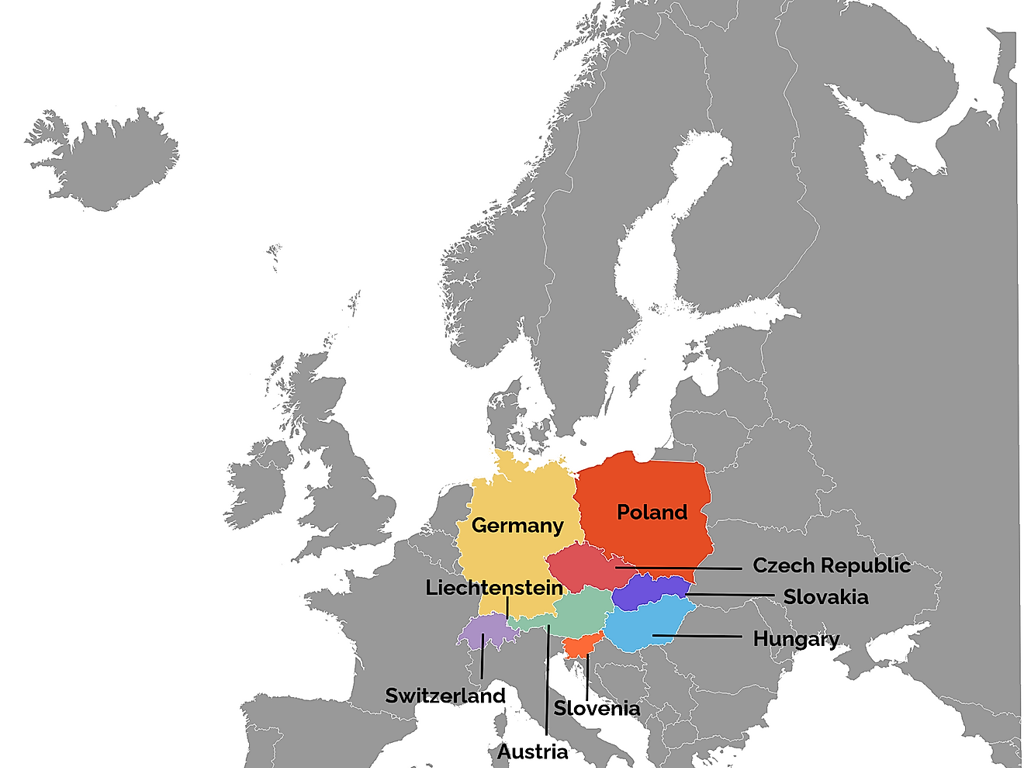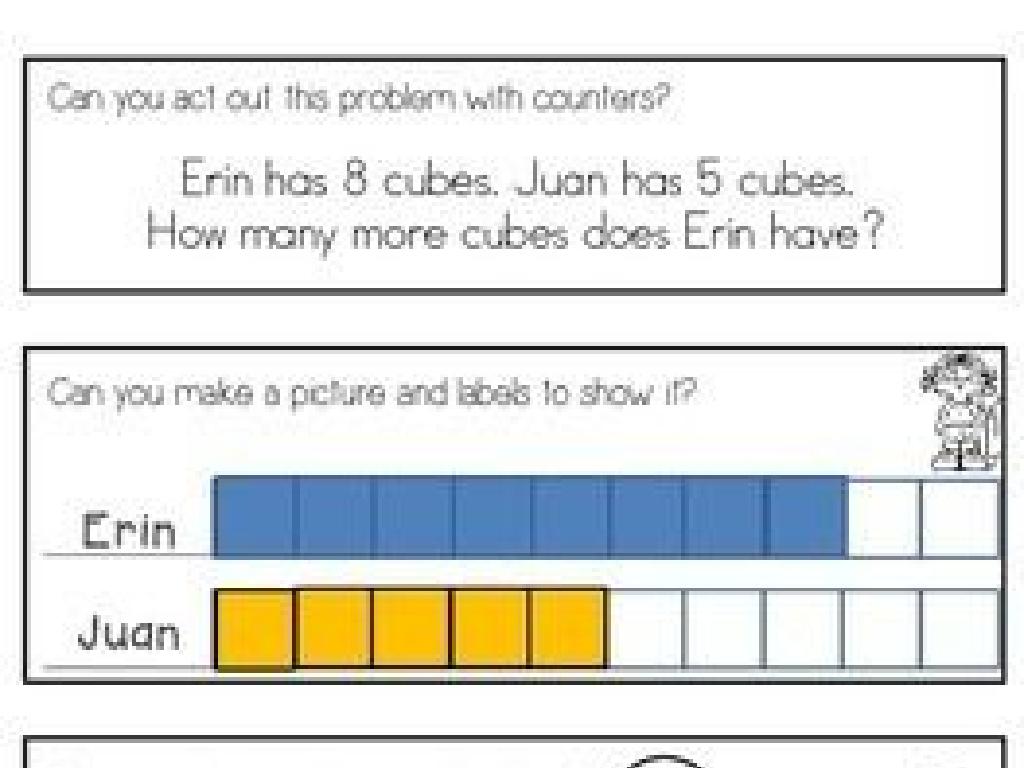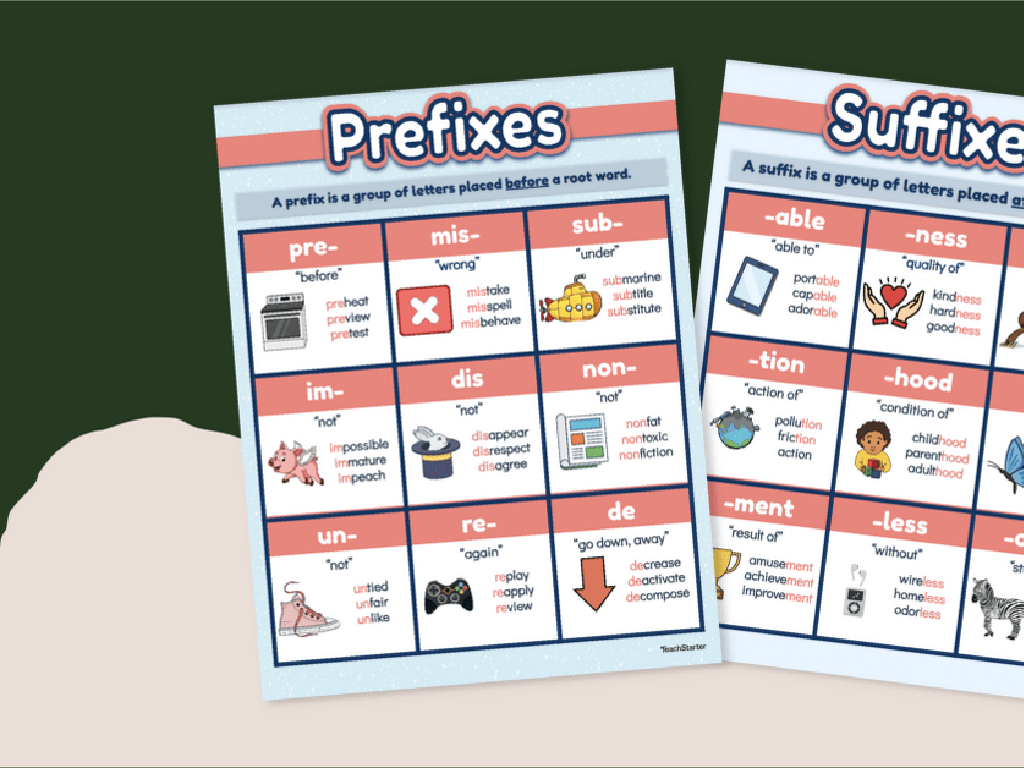Multiply Fractions By Whole Numbers I
Subject: Math
Grade: Fifth grade
Topic: Multiply Fractions And Whole Numbers
Please LOG IN to download the presentation. Access is available to registered users only.
View More Content
Multiplying Fractions by Whole Numbers
– Quick recap on fractions
– Fractions represent parts of a whole, like 1/2 a pizza
– Understanding multiplication
– Multiplication means adding a number to itself repeatedly
– Today’s goal: Multiply fractions by whole numbers
– We’ll learn how to multiply a fraction by a whole number, like 1/2 x 4
– Visual examples for clarity
– We’ll use pictures to show how 1/2 x 4 equals 2 whole pizzas
|
Begin with a brief review of fractions to ensure students recall that fractions represent parts of a whole. Reinforce the concept of multiplication as repeated addition. The main objective of today’s lesson is to teach students how to multiply a fraction by a whole number. Use visual aids, such as pie charts or pizza illustrations, to demonstrate this concept. For example, show that multiplying 1/2 by 4 means finding the total of four 1/2 pizzas, which equals 2 whole pizzas. This visual approach will help students grasp the concept more concretely. Encourage students to think of real-life examples where they might use this skill.
Visualizing Fraction Multiplication
– Imagine pizza slices for real-life fractions
– If you have 3 friends and 1/2 a pizza, how much does each get?
– Use number lines for fraction multiplication
– Marking fractions on a line helps see the multiplication process
– Create your own fraction multiplication stories
– Think of scenarios where you share or combine parts of a whole
– Activity: Fraction storybook creation
|
This slide introduces students to the concept of multiplying fractions by whole numbers through visualization techniques. Start by asking students to imagine dividing a pizza into equal slices, which represents fractions in a tangible way. Then, demonstrate how multiplying these fractions by a whole number can be visualized on a number line, which helps students understand the concept of scaling a fraction up. The activity involves students creating their own stories that involve fraction multiplication, such as sharing food or combining ingredients in a recipe. This hands-on approach encourages students to apply their knowledge creatively. For the activity, provide guidelines for creating a story that includes a clear representation of fraction multiplication, and offer examples to inspire them.
Multiplying Fractions by Whole Numbers
– Write the multiplication problem
– Turn the whole number into a fraction
– Example: Convert 3 to 3/1
– Multiply the top numbers (numerators)
– If 1/2 x 3, multiply 1 (numerator) by 3
– Multiply the bottom numbers (denominators)
– Since 3 is 3/1, multiply 2 (denominator) by 1
– Simplify the fraction (if possible)
– Reduce the fraction to its simplest form
|
This slide provides a step-by-step guide for fifth graders on how to multiply a fraction by a whole number. Start by writing the problem clearly. Next, convert the whole number into a fraction by placing it over 1. Then, multiply the numerators to get the new numerator. Do the same for the denominators to get the new denominator. Lastly, simplify the fraction if possible to get the final answer. For example, multiplying 1/2 by 3, we convert 3 to 3/1, multiply to get 3/2, which simplifies to 1 1/2. Encourage students to practice with different problems and ensure they understand each step before moving on.
Multiplying Fractions by Whole Numbers
– Example 1: Multiply 1/4 by 3
– 1/4 x 3 equals 3/4, because you have three 1/4s
– Example 2: Multiply 2/5 by 7
– 2/5 x 7 equals 14/5, which is the same as 2 and 4/5
– Step-by-step solutions
– We multiply the numerator by the whole number
– Practice together in class
– We’ll solve these examples as a class activity
|
This slide introduces students to the concept of multiplying fractions by whole numbers through two example problems. Start by explaining that multiplying a fraction by a whole number is like adding the fraction to itself that many times. For example 1, show that 1/4 multiplied by 3 means you have three 1/4 pieces, which equals 3/4. For example 2, demonstrate that multiplying 2/5 by 7 gives us fourteen fifths, which can also be written as 2 whole and 4/5. Walk through each step, emphasizing the multiplication of the numerator and keeping the denominator the same. Encourage students to participate by solving the problems together as a class activity, ensuring they grasp the concept and can apply it to similar problems.
Practice Time: Multiplying Fractions by Whole Numbers
– Problem 1: Multiply 3/8 by 4
– Multiply the numerator (3) by the whole number (4)
– Problem 2: Multiply 5/6 by 2
– Multiply the numerator (5) by the whole number (2)
– Discuss your solutions
– Share answers with a partner
– Compare and learn from each other’s work
|
This slide is designed for students to apply their knowledge of multiplying fractions by whole numbers through practice problems. Encourage the students to multiply the numerator by the whole number and keep the denominator the same. After solving, they should simplify the fraction if possible. Students should work independently on the problems and then pair up to discuss their solutions. This peer interaction will help them understand different approaches and correct any mistakes. As a teacher, circulate the room to offer guidance and support where needed. Be prepared to provide additional problems for students who finish early or need extra practice.
Understanding Your Mistakes: Multiplying Fractions
– Review common multiplication errors
– Mistakes like over-simplifying before multiplying or incorrect addition of fractions instead of multiplication.
– Steps to check your work
– Use inverse operations to confirm results. For example, if 1/2 x 4 = 2, then 2 ÷ 4 should equal 1/2.
– Encourage questions about fractions
– Practice problems for self-check
– Solve and check: 1/3 x 6, 2/5 x 5, 3/4 x 4.
|
This slide aims to help students learn from their mistakes when multiplying fractions by whole numbers. Start by discussing common errors, such as simplifying fractions incorrectly or adding instead of multiplying. Teach them the importance of checking their work by using inverse operations. For instance, if they multiply a fraction by a whole number, they can check their answer by dividing the product by the whole number to see if they get the original fraction. Encourage students to ask questions they may have about multiplying fractions to clarify any confusion. Conclude with practice problems that students can solve and then check their answers to reinforce the concept.
Class Activity: Fraction Multiplication Stories
– Craft a multiplication story
– Use fractions and whole numbers in a real-life scenario
– Illustrate with a drawing
– A visual representation of the story helps understanding
– Present your story to the class
– Sharing stories helps learn from each other
|
This activity is designed to help students apply their knowledge of multiplying fractions by whole numbers in a creative and engaging way. Students should think of everyday situations where fractions are used, such as cooking or dividing items, and create a story around it. They should then draw a picture that represents the story, which will aid in visualizing the concept. When presenting, encourage students to explain how they multiplied the fractions and whole numbers in their story. Possible activities could include baking, where a recipe is multiplied for more servings, or sharing items among friends. This will not only reinforce their understanding but also improve their communication and presentation skills.
Wrapping Up: Fractions & Homework
– Excellent work in today’s class!
– Homework: Fraction multiplication worksheet
– Practice multiplying fractions with whole numbers to master the concept
– Next lesson: Dividing fractions by whole numbers
– Get ready to learn how to divide fractions by whole numbers
– Keep practicing and ask questions if needed
|
Today’s class focused on multiplying fractions by whole numbers, and the students did a great job grasping the concept. For homework, they are assigned a worksheet that will provide additional practice to reinforce today’s lesson. It’s important for students to complete this to ensure they are comfortable with the material. In the next class, we will transition to dividing fractions by whole numbers, building on the knowledge from today. Encourage students to practice and to reach out with any questions they may have before the next class. This will help them stay confident and prepared for the upcoming lesson.





